1. Events as yet inexplicable other than by
postulating the existence of an unclassified organism.
2. Events in which natural phenomena are fortuitously
recorded in such a way that they cannot be recognised
3. Events staged for the purpose of being recorded and
then misrepresented as being an unknown animal
Material can and does shift between categories over time, invariably downwards. I have only seen one item which involved moderately complex manipulation of the image after shooting ( I exclude Doc Sheils efforts - since they were not moderately complex!) and that is the "2001 Pt Charlotte Lake Champlain sequence", which seems to have involved modern non-linear editing of digital video.
I am not aware of any material remaining in Category 1.
In the past few years, the Internet has thrown a lifeline
to fakers and publicity seekers, by-passing the usual filter of editorial
control or balancing comment. The Web is awash with faked and mis-identified
pictures, some winning spurious prizes awarded by anything but impartial
judges, all in the pursuit of publicity. It is a pity that some of the
individuals involved seem unable to differentiate between reality and the
strange little worlds they have created on their hard drives!
What do you think of Dr Rines and his ideas of tracking and filming a moving object in the loch?
I have not spoken with him about his research recently and I do not know what his ideas in this area are. Most technical underwater investigations are now enlivened somewhat by the knowledge that there is likely to be one or more seals in Loch Ness at any given time, and since these exhibit exactly many of the features of Nessie sightings, films and sonar contacts, remote sensing techniques will need to be evolved to cope with this new, complicating, information.
Dr Rines is at liberty to pursue whatever line of inquiry
he chooses. Most of us have modified our approach to research or investigation
in the light of new information over the last three decades, but Bob's
approach is as valid now as it was thirty years ago. None of
us have turned up one iota of scientifically valid evidence for any
biological "monster". The most significant development is the realisation that
seals frequently enter the loch, and probably account for many of the sighting
events.
"And what if some sea serpents and lake monsters are not elasmosaurus but long-necked seals?" wrote a leading American "cryptozoologist" author recently.
Surely he is not seriously suggesting that there continues to exist a large unclassified and radically different pinniped (or reptilian) species in our rivers, lakes and coastal waters which has evaded finding or capture either alive or dead by the entire world's coastal dwelling population and fishing fleets since time immemorial?
Of course I may have misunderstood his comment - we frequently see seals *showing* a long-ish neck as demonstrated in Maurice Burton's book, but they are just ordinary seals, and they do frequent our lakes, lochs, rivers vatnets and firths.
But he did write " I happen to be one who does not accept that if there are animals in Loch Ness, they are reptilian leftovers from Jurassic times. I'm in the large pinniped, Pleistocene-Holocene school."
Perhaps he was serious!
I think the Spicer sighting could
have been an otter with a young otter in its mouth...
I have only seen a live otter twice in twenty years despite the fact that they are known to hunt in front of my house almost daily. The only one I have seen near Loch Ness was dead at the roadside at Loch Dochfour, about ten years ago. (Update - I filmed one in Urquhart Bay in July 2004 :-) )
On the other hand, it is quite normal to see deer crossing
the road - about one journey in five - and I would regard a couple of deer
distorted in a heat haze as being a more likely cause of a sighting on the
Dores - Inverfarigaig road.
What was the animal in the bushes with
something pink in its mouth?
This is probably a
reference to Mrs. Eleanor Price-Hughes sighting in 1933. Remarkably, there are
two perfectly reasonable explanations for this which I have seen myself at
close range. On the day in 1999 that I filmed the seals in Loch Ness, I saw
one of them eating, or playing with, a half-eaten salmonid fish, which was of
course pink. This seal was in very shallow water, close to bushes, and if the
witness only caught a brief glimpse of the event she would not necessarily
have recognised what she had seen. The second possibility
is that she caught an incomplete glimpse of a cow wading in the water - they
have pink tongues.
The Lake Champlain Port Charlotte 2001 video file
I have had a look at this QuickTime file and my comments are based wholly on the assumption that it is presented as an unedited "straight" conversion of video footage to a computer-friendly format.
If this file - I say file rather than film - had been presented to me at Loch Ness as "a film of the monster" I would have some reservations about its "genuineness".
If you examine it carefully frame by frame, you see that some frames are virtually identical to the previous one while others are radically different. This strongly suggests that many frames have been removed - probably in digital video editing software - so creating the effect of a higher speed than the object actually had.
I took the liberty of saving some frames after the object reappears from the bottom of the frame, counting that "re-appearing" frame as frame 37. Frames 37, 38 & 39 are radically different, while 39 and 40 are practically the same, and are then followed by more "different" frames. This is not consistent with hand-held footage shot at either 25 or 29.97 fps because the camera operator would not be able to bring the camera to rest in 40, or 33, milliseconds before resuming the camera movement in the next frame.
Similar pairs of near identical frames occur at 63/64, 77/78, 82/83 and 101/102 while between 100 and 101 there is a big difference. The very similar adjacent frames are probably just errors in the editing.

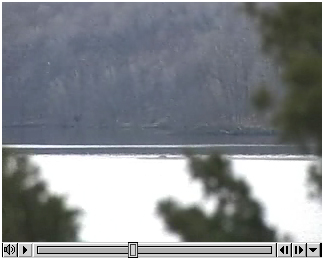
Frame
100 Frame 101
A critical example comes at frames 100 and 101 where the
well defined long hump (not motion blurred) changes to a much shorter (but
equally well defined) hump in the space between 2 adjacent frames. As the
frames are recorded at intervals of 40 milliseconds (25 fps rate) I can only
point out that the linear dimension of this "hump" reduces from about 25
pixels to 8 pixels in less than this period without showing any blurring. If
that hump were 6 feet long, the ends would have to move towards the middle
with a closing speed of 90 miles per hour if it were to become only 2 feet
long in the time available, and that would surely cause a disturbance in the
water!
As the camera operator skilfully and
speedily pans from right to left following the fast hump, I am amazed that the
background is not much more blurred than it is.
I suspect that the object was actually
the occasionally breaking wave left by a passing boat which was filmed over a
much longer period and then had its apparent progress speeded up by the deletion of perhaps 4 frames out
of every 5. There is clear evidence
of breaking wave crests around frames 41-42, 111-112, and 184-185.
Around frames 95-100 a light object on the far shore -
possibly a sloping pale tree branch - suddenly becomes obscured and then
revealed again, and I would regard this as consistent with it being covered by
the wave making up the other half of the Vee-shaped wake. These are frequently
invisible from the back view.
If this film had been made at Loch Ness, it would certainly be labelled as Nessie until it was identified as something else or the novelty wore off and the perpetrators confessed.
I would not disagree with that label - Nessie
is a default term for anything seen, photographed, film, heard, felt or
smelled at Loch Ness which cannot be identified. It remains Nessie until it IS
explained. This might be 100 milliseconds or 100 years I imagine the same ground rules apply on Lake Champlain.
Eye-witness evidence - a true
sample accurately reported?
A local monster fan club promoter recently wrote "I
hope that the new production at the original centre is better than before -
I understand that all the eyewitness
evidence is unexplained and was put forward by genuine people.
Well, he should know because he
comperes the show.
This brings up an interesting point. Whether a "sighting" - i.e. observation of an unknown object or disturbance - is recorded or not should be a matter of pure chance. The filmed or photographed sightings should therefore represent a true sample of all sightings.
So if 90% of all the photographed sightings could be explained away, that would leave 10% in support of an unclassified creature or monster. Similarly 10% of eye-witness reports could be taken as being of an unclassified creature.
It is therefore time to discuss why it should be that ALL the filmed and photographed sightings can now be explained without invoking a monster, and almost invariably these credible explanations have been by people who were NOT there at the time...this strongly suggests that the events which went unrecorded except by visual observation would also have been amenable to explanation, by other people, in the fullness of time, had a camera been to hand.
Whether something is unexplained or not can depend entirely on how hard you try. The fan club web site records all the classic pictures and fails to mention that they are all explained - including Wilson, Gray, Stuart, McNab, O'Connor right through to Bavister and Joth.
It is also necessary to point out that
honesty, integrity and reputation have absolutely nothing to do with an
ability to make an accurate observation - this comes only with
training.
and more from the official fan
club
"22 February 1999
For the first time in since June 1963, Nessie was spotted out of
the water on the shores of Loch Ness by an American visitor to the area.
This unique sighting took place at
8.30 in the evening on the beach
between Dores
and Foyers where the creature, said to be between 10-15 metres in length with
a long neck, scurried off into the water as the man approached."
| *Unique indeed -at the time and date mentioned, it had been dark for about four hours! |
Have you ever investigated the depression known as "Edward's Deep"?"
The story of Edwards Deep - I admit that I suggested the name - originates with the skipper of a local tour boat George Edwards, who picked up depth readings of 247 metres, or 812 feet on the fishfinder sonar on his cruise boat "Nessie Hunter".
I worked as relief skipper on the "Nessie
Hunter" for ten years and agree that the
boat's sonar does produce these signals from time to time, but I'm not convinced that they are a true
indication of depth...it would be hard to explain how a 60 foot crater in the
otherwise incredibly flat bottom sediment did not fill up. My guess is that
the equipment is being electronically confused by a sidewall echo.
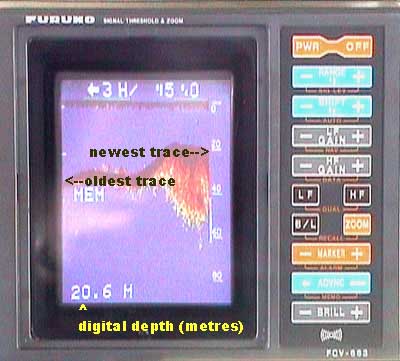
The Furuno sonar on "Nessie Hunter"
What is a side-wall echo?
In simple terms, it is an echo picked up from the side
of the loch when the side is still further away than the bottom directly
below the boat.
I have an example of a similar echo below, except Raynor's Deep, at 263 metres, is much deeper than Edwards'. As can be seen at the end of the clip, it was filmed quite close to Urquhart Castle.
Copyright Dick Raynor 2009
The area has been investigated thoroughly with sonar, and also with tv cameras, which have so far failed to reveal anything special. The sonar on the Castle Cruises tour boat which I now skipper is the same type as George's, and so might reasonably be expected to behave in the same way, but the Loch Ness Project boat Deepscan has a different sonar, which does not pick up such "deep" returns. The latest published material is in the Loch Ness Project's Archives - here.
The newest Admiralty Chart of the area is based on data gathered during a joint Loch Ness Project / BBC Science Unit survey in 2002. The maximum depth recorded in the survey was 227 metres, despite special attention being paid to the area of "Edwards Deep". This depth is less than 3 metres different from that recorded by Murray and Pullar in 1903.
If the Loch Ness Project / BBC data is good enough for Her Majesty's Hydrographer, it is good enough for me.
Passengers on George Edwards Cruise boat "Nessie Hunter" will also be familiar with the photograph he took in 1986, now available for sale on the boat for 50 pence. I remember him telling me at the time how hard it had been to drag the water filled tube out of the back of a van and down to the water before it was towed out into the loch!
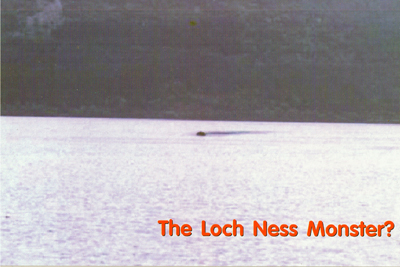
I'll let George tell his modern version of the story behind it himself - just play the movie below.
Do you know of any pictures that were taken of the sunken Nessie prop that was briefly used in the 1970's Sherlock Holmes movie?"
I'm not aware of any pictures taken after it sank - I am
not sure it's position is even known - but I did see some pictures of it in
use on the set once.
Would you have any idea as to how long would it take for sediment to cover a plesiosaur sized skeleton on the floor of the loch?
The sediment appears to have varying consistency in different locations, ranging between exposed putty-like glacial clays which I found in '73 (indicating no net deposition at that location) and metres-thick layers of ooze that you can almost swim through, should you feel so inclined.
In some locations skeletons of the seals shot by the Ness District Salmon Fisheries Board might remain visible for several years, while in other locations they might sink into the mud within a few months.
Exposed bones are not likely to survive for decades however
as the 'calcium hungry' loch water will cause them to dissolve and crumble in
the slightly acid environment. A new web
site has a lot more scientific information
about the Loch Ness environment.
I read in the paper that a witch
had blessed a web-cam above Urquhart Castle, run by
Nessie-On-The-Net, but when
I logged on, it was the same pictures over and over again.
Er, Yes. Apparently a case of "Mixed Blessings". Someone else has pointed out that the other nearby web cam (100 metres away) showing the same view seems to be afflicted by quite different weather conditions, and, amazingly, when the CamVista unit showed it had got dark, the high-tech "digital" camera at Nessie-on-the-Net was waving two of them and still clearly showed that Loch Ness was not yet affected by the Earth's rotational solar occultation. Mikko and Gary do urge you to "engage sense of humour" before descending to their premises! It has been pointed out that the images also seem to continue to change after people have disconnected their modems!
A computer enhancement of the
Dinsdale Film clearly shows more parts of the monster under the water, so it
can't possibly be a boat like the sceptics claim.
"Computer enhancement" has come a long way since 1972, but still cannot see under a distant water surface. This is because light approaching the water surface from any submerged object at an angle greater than 48 degrees from the vertical encounters total internal reflection within the water. In other words, the "image" of a boats propellor is simply reflected back into the water - as if the water surface, viewed from beneath, looks like a mirror. Clearly, the surface of Loch Ness is rarely if ever perfectly calm, and this further reduces the likelihood of a coherent image of any submerged object being visible above the surface.
A good example of the problem can be seen by standing at the side of any pond or lake. When looking right down into the water at your feet you can see the bottom very well, but the further you raise your head to look into the distance, the less well you can see any submerged object, as the image is increasingly mixed with the reflection of the view above the surface. This is simply because an increasing proportion of the light rays from any submerged object are being reflected at the water surface rather than being refracted through it. If there is a breeze, the smallest ripples break up the image beyond recognition.
To get back to Tim Dinsdale's Film, the angle of view of the object is only in the range of 3 to 4 degrees from the horizontal, and I can see no way that anything under the surface could possibly be seen, let alone recorded on film, under those circumstances. On this basis, computer enhancement of any claimed underwater portions of the object would have nothing but spurious data to work on. Any dark areas appearing intermittently in the vicinity of the Dinsdale hump are likely to be reflections of the shore behind it. See the new page on this subject.
The greatest achievement of "computer enhancement" at Loch
Ness, the so-called "Flipper Picture" taken with a time-lapse strobe camera in
1972, is nowadays not without its critics. Few people have seen the original "un-enhanced" picture circulated
in the early 1970's, and fewer still would recognise it, so great is the
"enhancement".
It is, however, reproduced on
this web site - without an explicit label! See if you can find
it.
What do you think
about monster stories from other lakes?
Apart from a few trips to Loch Morar and some other Scottish locations I have not visited any of the other "major" monster lakes, so I do not claim first hand knowledge of the lakes themselves. I have looked fairly closely at bird and boat-wake videos from Norway and Sweden, and read eye-witness reports collated by Mr J.O.Sundberg with some care, and it would seem that phenomena similar to those at Loch Ness are filmed and reported in Scandinavia. It seems likely that they have similar causes, with the added knowledge that the European Catfish is known to be resident in some of the Swedish lakes.
.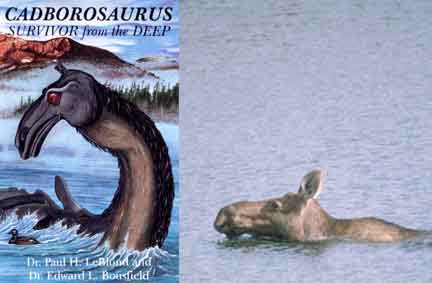
Cover of LeBlond - Bousfield book and swimming
moose - photographer unknown.
In North American lakes the usual bird and boat wakes confuse many people, large fish including sturgeon species are known to occur, and moose, known in Europe as Elk, can swim if necessary. These, incompletely observed, have produced a rich tapestry of imaginary creatures, or rural legends, eagerly consumed by the large indigenous population of "cryptozoologists". The biggest mystery of all is why people should prefer the extremely improbable explanations over the logical and commonplace ones...and do they make all their life decisions in this manner?
Is this Nessie?
You must decide!
So say some other web sites with pictures of "blobs on the
water" and then invite the reader to decide for themselves based on the
information supplied (usually none) whether the picture is "genuine" or not. Anyone can make a
blob appear on a photo of the surface of Loch Ness (hint - don't make them too
dark) so this is essentially a waste of bandwidth.
"THIS IS STORSIE - A SWEDISH SEA
SERPENT"
So claims the GUST web site at the beginning of
October 2001. It goes on to show a picture of a water surface with three near
parallel lines on it, one of which, the nearest, has a series of humps on it.
It is essential that anyone engaging in "lake monster research" learns to
recognise basic lake activity in order to avoid making embarrassing mistakes.
Investigators should train themselves by looking at normal events from many
different angles and producing either a mental or written Key to Surface Events. This one
clearly hasn't, and that doubtless accounts for his continuing success in
cryptozoology. Despite this claimed success he has not actually described any
new species yet.
The most common large objects seen moving on the surface of lakes are called boats, and the waves they leave behind are the cause of many "monster sightings". A illustrated discussion of boat wakes is under construction here, but in the meantime readers should relax, and check for evidence of a boat wake in the latest Storsie pics. A wake consists of three elements, the nearest arm of the bow wave, which may have breaking waves visible in it, the prop-wash further away, directly behind the boat responsible, and the other arm of the bow wave, furthest away (highest up) in the picture. The closer to the water the camera was located, the more parallel the lines will appear, but there will usually be a convergence which points in the direction the boat has gone. Always check the nearest arm of the wake for a continuation of the line "ahead" of the monster itself - it will nearly always be there, and should not be, after all the monster hasn't got there yet!
When you are ready, take another look at the Port Charlotte
& Button Bay "Champ" pics, the Loch Ness MacNab photo, the Mansi picture
(intentionally mentioned after MacNab!) and spot the elements for
yourselves.
![]() claims an official loch ness monster fan club, and lists around a
dozen "sightings" a year over the past few years. Out of 57 sightings, 12 were
reportedly photographed, although none of those photographs are shown on the
fan club's web site. 7 sightings were of wakes only.
claims an official loch ness monster fan club, and lists around a
dozen "sightings" a year over the past few years. Out of 57 sightings, 12 were
reportedly photographed, although none of those photographs are shown on the
fan club's web site. 7 sightings were of wakes only.
Insurance against monster attack now
available ( Press report July 1999)
"Gary's monster
insurance".
TOP Nessie hunter
Gary Campbell, president of the Official Loch Ness Monster Fan Club, has
insured himself against the possibility of the monster causing him
injury.
The Invemess-based BBC broadcaster is now covered for £l million for "death or permanent total disablement occasioned by the Loch Ness Monster".
Gary, a fanatical monster hunter for years, said yesterday: "I feel safe to go out on the loch. If anything should happen to me, my family will be well looked-after."
"I know Nessie hasn't attacked anyone since St Columba had words with her in 565AD, but I'm more worried she may come up and accidentally knock me out of the boat. It's better to be safe than sorry."
He said Nessie had been spotted once this year so far, by an American tourist.
The Nessie-Safe All Aquatic Risks Insurance was arranged through specialist brokers GRIP of London.
Simon Burgess of GRIP said: "We already cover alien abductions and virgin births, but this is the first time we have been asked to insure against injury by Nessie." *
The policy's conditions also allow a claim for post-traumatic stress disorder.
Gary added: I might need to claim on that part if the American Dan Taylor turns up with his submarine this summer.
"He has threatened to harpoon Nessie, which 1 think might be very dangerous for all."
Gary is offering the policy to other Nessie fans. He claims that at £250 a year it's a must for all serious monster hunters.
He is taking part in a gathering of
international monster hunters on Loch Ness next month and feels many
participants might want peace of mind before taking part in the hunt.
"
(* I'll buy shares in that
company! -Ed)
Two new
webcam systems officially launched
Visit the
dedicated page by clicking on the red text. There are presently operational
web cams at Temple House (surface), Temple Pier (underwater) Strone (surface)
and MV Deepscan (mobile or underwater, selectable).
Monster
Pictures which will stun cryptozoologists all over the world?
Perhaps! This depends upon your definition of
"cryptozoologist", and "stun". The journalist web-master encourages us to be
stunned several times each year, so far without success, with his pictures of
birds and boat-wakes.However, on Sunday October 20th 2001 I managed to film
this group of lake serpents near Urquhart Castle, clearly line astern on
migration to Lake Seljord, or at least heading North-East, so perhaps he was
right all along.
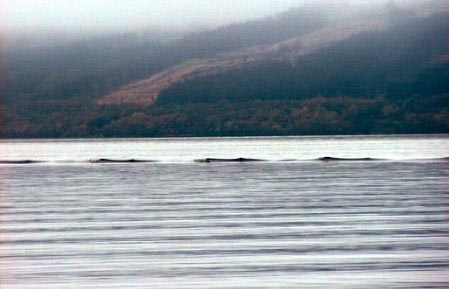
Fearsome monsters migrating to Norway Copyright 2001 Dick
Raynor
But I doubt it.The latest claims are based on a two second ( yes, 2 second) long sequence of which only one frame is reproduced, and at the time of writing was to be seen here.
Whether it is a boat wake with breaking waves, as seen above, or a groups of birds running along the water surface, as seen below, is not immediately clear but I cannot see how anyone can claim it to be
"THE UNDENIABLE PROOF THAT IT REALLY EXISTS" . Once again, a "monster" is being invoked as the default cause and explanation for something which could not be identified at the time due to inadequate observation or knowledge, and this is entirely unjustified. The Scandinavian Lake Serpent may or may not exist, but the repetitious grasping at straw-like images and reports of boat wakes, birds. seals and debris by its supporters does nothing to keep it afloat.
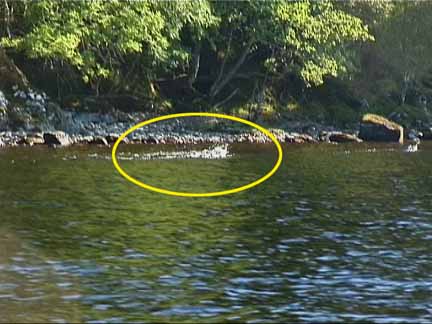
Copyright 2001 Dick Raynor
Did Dr Rines team find a "Dead Nessie" in July 2001?
Visitors to the Academy of Applied Science web site will see a smallish black and white image and a narrative explaining how "our remote underwater video camera vehicle (ROV),... came upon what is strongly suggestive of a decaying "animal" carcass in 333 feet of water (pictured left) near the mouth of Urquhart Bay".
It is not immediately obvious what the image shows, nor is any estimate of size given, so the range of possibilities extends between timber debris, through dead fish, to the dead mammals and parts thereof routinely despatched to the deep. Animal carcasses in Loch Ness will include deer, and seals which are shot by the Ness District Salmon Fishery Board. This practice is applied to both Harbour Seals and to endangered Grey Seals, the third rarest species in the world.To answer the question, then, the answer is possibly yes, if one accepts that seals account for a good number of "Nessie" sightings, and if the carcass is that of a seal.
Update June 2002 - Dr Rines' team is back with a variety of ROV's, - three at the last count - so we may learn more if they manage to relocate their earlier targets.
Update August 2003 - The team is back again, with an even bigger ROV.
OCCUPATIONAL HAZARD # 1 - JAN-OVE SUNDBERGAnyone with an active interest in mysteries such as alleged lake monsters will from time to time exchange messages or establish some sort of friendship with people who appear to have similar interests, and this has led me to many lasting correspondences and instructive discussions.
Occasionally, however, I have met people who turn out to be exploiters of the relationship, and I simply have to deal with it. Until a couple of years ago, my instincts had only let me down once, and that was 30 years ago with Frank Searle. More recently, I communicated with Jan-Ove Sundberg, and after initially friendly exchanges he became increasingly confrontational.
For over a year I have ignored the rubbish published about me, my associates, and my former associates by Jan-Ove Sundberg on his web sites but I have now (6th January 2002) received the email message which follows. Potential sponsors and supporters of Global Underwater Search Team (GUST) may find it interesting. Please use my search engine to find evidence of any attempt to discredit him (other than by simply quoting him!)
Received from Jan-Ove Sundberg, 6th January 2002:"Duck Raynor:
I see that you have decided to discredit me as much as possible these days,
when neither you nor the charlatan (name removed) could get to me in any
other way.This gives me a clean bill to publish the 200 email we exchanged a few
years ago, in which you among other things say´s that the local are liars,
that the locals illegally kill seals which strays into the loch, etc. etc.
I wonder what local business men is going to say about this? There is many
other goodies in your email and I bet there´s going to be a lot of raised
eye brows once they are published.I hope you have a miserable life in 2002, that bad luck will befall both
you and your family and that my revelations will bring you nothing but trouble.Jan
From this email, you can see what a nice chap he is, and decide for yourself if you would like to support his work. The matters he threatens to "expose" are already fully discussed elsewhere.
If Mr Sundberg decides to break normal conventions and publish private correspondence, I will make sure that it is completely correct, but his deplorable behaviour and legendary verbal abuse of people for whom he has no further use, from waiters to film producers and sponsor's company directors, have already sealed his fate in the Inverness area, and far beyond.
UPDATE: June 2002...more nonsense published - read my response here.
AND....... June 2002...he now says Nessie is bubbles caused by seismic explosions in the loch's bottom...here is an extract of his findings:"Could the pressure from the seismic explosion reach the surface too and take the shape of a monster such as the alleged Nessie? Yes, that´s perfectly possible and if you on top of that has a vivid imagination, as many Scottish people have, because most of them are fairy tellers, a monster like Nessie will be created inside your head and projected on the seismic pressure wave at the surface."
Still, they did give us Volvos and Abba!
"Man Monster and Mysteries" - Directed by Ken Peterson
Hidden in the restored DVD version of the Walt Disney classic "Pete's Dragon" is a little gem! Apart from the main title, there is a section called "Bonus Material" which includes a "Featurette" called "Man Monster and Mysteries". This is the now classic documentary footage by Ken Peterson in 1969 / 70, and includes interview sequences with Hugh Ayton, Lady Maud Baillie, Alex Campbell, Isobel Cameron, Freddy Cary, Tim Dinsdale, David James, Ted Holiday, Roy Mackal, Ivor Newby, Dan Taylor and non-speaking glimpses of Holly Arnold, Peter Davies, Rip Hepple, Clem Skelton, Ken Wallis, a whole crew of LNI volunteers, and lots of Drumnadrochit school-children. It even includes part of Tim Dinsdales film! "Man Monster & Mysteries" runs for 24 minutes, and you'll want to watch it over and over again.If you buy it now through this web site we'll get commission too!
WHERE DO I REPORT A SIGHTING? - HERE!A BRIEF HISTORY
For the first thirty years or so of the Nessie story, reports usually found their way into public knowledge via the local newspapers, notably the Inverness Courier. In 1933, as the story developed, there was a media frenzy ( as we would call it today) and publicity seekers homed in. Some people saw things they could not identify, and after mentioning it to friends, reporters got to hear of it.The rest, as they might say, became history. Not necessarily accurate, but history.After a spate of activity at the end of the 1950's and into the '60's, when people were all too willing to have their minds taken off the seemingly inevitable end of the world, the Loch Ness Phenomena Investigation Bureau was set up to act as a "clearing house for information", and with the establishment of its Achnahannet HQ site in 1964 there was a new place to report sightings. The LNI HQ was closed in 1973, but the some of the "exhibits" were transferred to William Owen's Great Glen Exhibition in Fort Augustus. Most of the media attention at that time was however focused on the fraudulent pictures being published by Frank Searle.
Adrian Shine and his team at the Loch Morar Project arrived on the scene in the mid-seventies, and from the early eighties there was a permanent exhibition at the Drumnadrochit Hotel, which has received a fair number of reports ever since.
With the rise of daytime television and the inevitable chat-shows, being a "monster-witness" has become a lucrative accident to have suffered, and present day witnesses sometimes have to be tracked down by researchers after their TV appearances.
The advent of the internet web cam at Loch Ness has made it unneccessary even to come to the Highlands to have a "sighting", and so it seems appropriate to be able to make sighting reports by the same means. The purpose, as ever, is to try to learn exactly what it was that happened for each and every sighting which occurred. The opinions expressed in our analyses are informed by years - decades even, of experience of Loch Ness, other lakes, and time at or by the sea, and some common sense. We have ourselves all seen things we cannot yet explain, and are eager to hear of your experiences.
If you have had some odd experience on or near a lake anywhere in the world which you think might be evidence or explanation of an unknown phenomenon, please let us know. Thank you.
There are currently web cams at five different locations on Loch Ness.
1. Above Temple Pier looking towards Urquhart Castle (the best of the fixed ones)
( not working in Summer 2004)2. Underwater at Temple Pier - usually just bits of weed in the shallows, but you will see sticklebacks and small fry up close at night feeding on invertebrates attracted to the light.
(Also not working in Summer 2004)Some watchers believe they have seen a plesiosaur-like head in front of this unit, but due to the relatively shallow deployment, I think this is more likely to be weed.
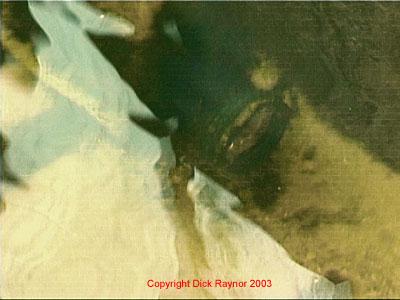
Underwater webcam on the bottom of Loch Ness
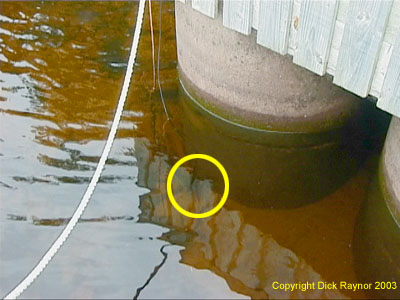
Underwater webcam on the bottom of Loch Ness
3. Above Urquhart Castle looking across the bay to Temple Pier.
4. On board M.V.Deepscan - potentially the most interesting as it shows the view from the boat during daytime cruises, but also transmits live from the 300m capable underwater television camera, or shows sonar screen, other instrumentation or deck activity when on Loch Ness Project research work.
Information about Loch Ness Project planned transmissions can be found on their web site.
Think you've seen parts of this section on Web Cams somewhere else?
They say imitation is the sincerest form of flattery!
The Academy of Applied Science team visited the loch during June in a continuing programme of underwater investigations. This year they had three ROVs, and hired two boats to deploy them from - the "Boy David", a retired fishing boat which can usually be seen tied up at Temple Pier, and Gordon Menzies' cruise boat.It is understood that they spent a lot of time looking for their "skeleton" from 2001, and also their " fried eggs", without public announcement of results so far.
Pictures of both of these targets have been on the AAS website , but it seems to have a number of broken links at present.
The AAS received very good coverage in the Inverness Courier recently when it was warmly congratulated on its third major by-product discovery in 32 years - the wreckage of John Cobb's boat "Crusader". The others were the Wellington bomber and the "prehistoric stone circle" in 10 metres of water at Lochend (which alas, unknown to the Courier, was identified as dumpings from a canal dredger!)
Unfortunately the Courier article went on to list among the AAS achievements the "celebrated Flipper Picture" of 1972, which, like the "Gargoyle Head Picture" of 1975, has long since been relegated to the file labelled "Lessons from Loch Ness". Perhaps the years of "reporting without comment" on which the Courier prides itself have lulled the writers there into an assumption that all Nessie stories are inherently baseless; any scientific objectivity is therefore pointless, and all who engage in it are doing so merely to damage the local tourist economy.
The only fly in the ointment of that argument is that it seems to place Money above Truth. I do not.
?
(section still under construction)